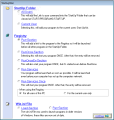Depending on how many applications we install every day or on a weekly basis, Windows is loading more and more components at startup. The small apps, like a text editor, image viewer or a browser, do not necessary add components to startup, but bigger ones, like antivirus, malware scanners and removers or power management software, claim a place in startup order. This is why it is very important to create a startup list, with delay time if necessary, in order to gain time at startup, because the hardware components are not always the sole cause for system slowdowns and crawling startups.
Situation: your PC is running a dual-core CPU > 1.5GHz with 2GB of RAM that is trying to load Windows, an antivirus product, a RSS reader that needs to check for the latest news, an Internet browser like IE or Firefox with 50 tabs to be opened, a few power management services and also a bittorrent client. The time between startup and complete load can be the same or smaller, if you choose to apply a delay between items or create a startup order, even if the system you are running is a single-core CPU with 1GB of memory. Sort the items that run at startup depending on the memory requirements and CPU usage level.
StartupStar was designed as a startup manager that enables you to control what programs load at Windows startup. The application comes with a 30-day trial period and “block function” disabled and runs on operating systems from Windows 9x to Windows 7. The test was made on Windows 7. For a fully functional version of the app you must pay $32 for a valid registration key. StartupStar will allow you to add new items to startup, as well as enable or disable items by switching to active or inactive mode.
The main window displays all the applications that are in startup. StartupStar allows you to sort the items depending on location; by default it reveals the entire item list but you can uncheck the location to hide it. The source locations are StartUp-Folder (and here you can sort by current or all users), Registry (divided by Run, Run Once, Run Once Ex, Run Services, Run Services Once) and Win.ini-File (with Load-Section and Run-Section).
Although I was pleased to discover Services selection, StartupStar does not display any, as opposed to what you find in the Services tab using the msconfig command (Start-Run-msconfig). The only items that are displayed are from registry Run location. If the Run option is unchecked, no item is shown. The Win.ini-File location belongs to older versions of Windows.
Adding a new item is easy. Enter the name, select the file (there is no file extension limitation) and, most importantly, select the startup source location. Each entry can be sent to inactive or active mode. If you consider changing the startup location for an existing item you must use Change / Info link. The available details provided by StartupStar are: Name, Entry (it displays the location on hard drive), Status and Location of Startup. A great option to add is “search over the internet,” which helps you find more information about the selected item (in case a suspicious entry appears).
In the case of some applications, once they are removed from the startup list, a new entry is made after reboot. In order to prevent this kind of activity, StartupStar allows you to set entry-block. This function will automatically remove the entry if a new startup call is made. Unfortunately, the Set Entry-Block option is available only in the registered version. Another limitation is represented by the nag screens. Every time you close or try to move an entry to another location you will be dropped a registration screen.
The User Interface of StartupStar comes with three different skins and five different languages (select the one you want from the About screen or the first time you run the application). The problem is that even if you select another language the program loads the English version instead. Every startup configuration can be saved using the backup function. The Backup manager window will allow you to restore the startup list in case the settings are lost or suspicious files are detected.
The Good
The Bad
The Truth
Every configuration can be saved and restored using backup manager. Only startup applications can be controlled; services are out of reach. StartupStar is not the ideal choice, considering the fact that Windows comes with System Configuration console ("msconfig" command), which can offer more control options (the block feature being available to registered versions only).
Here are some snapshots of the application in action:
 14 DAY TRIAL //
14 DAY TRIAL // 





